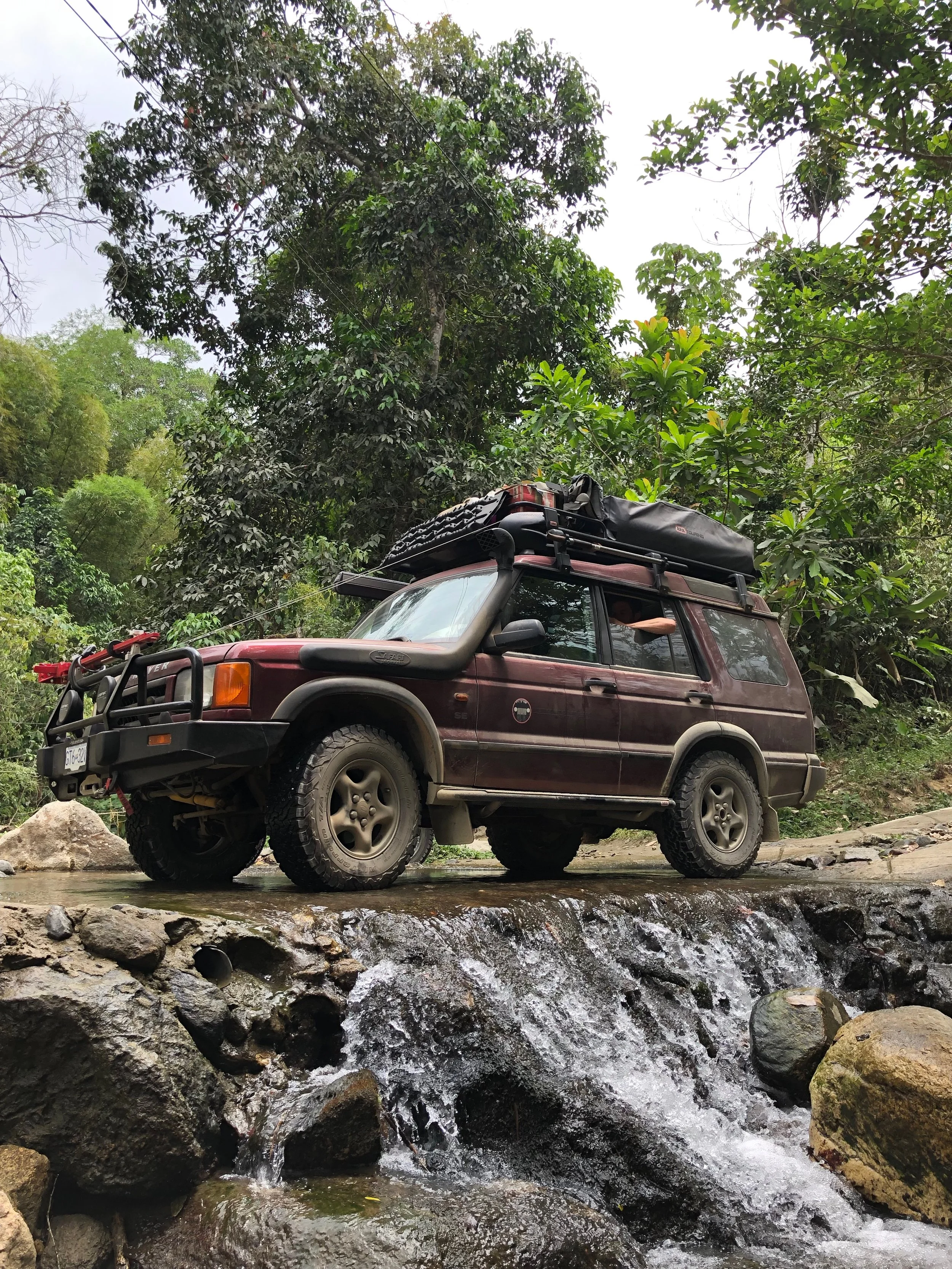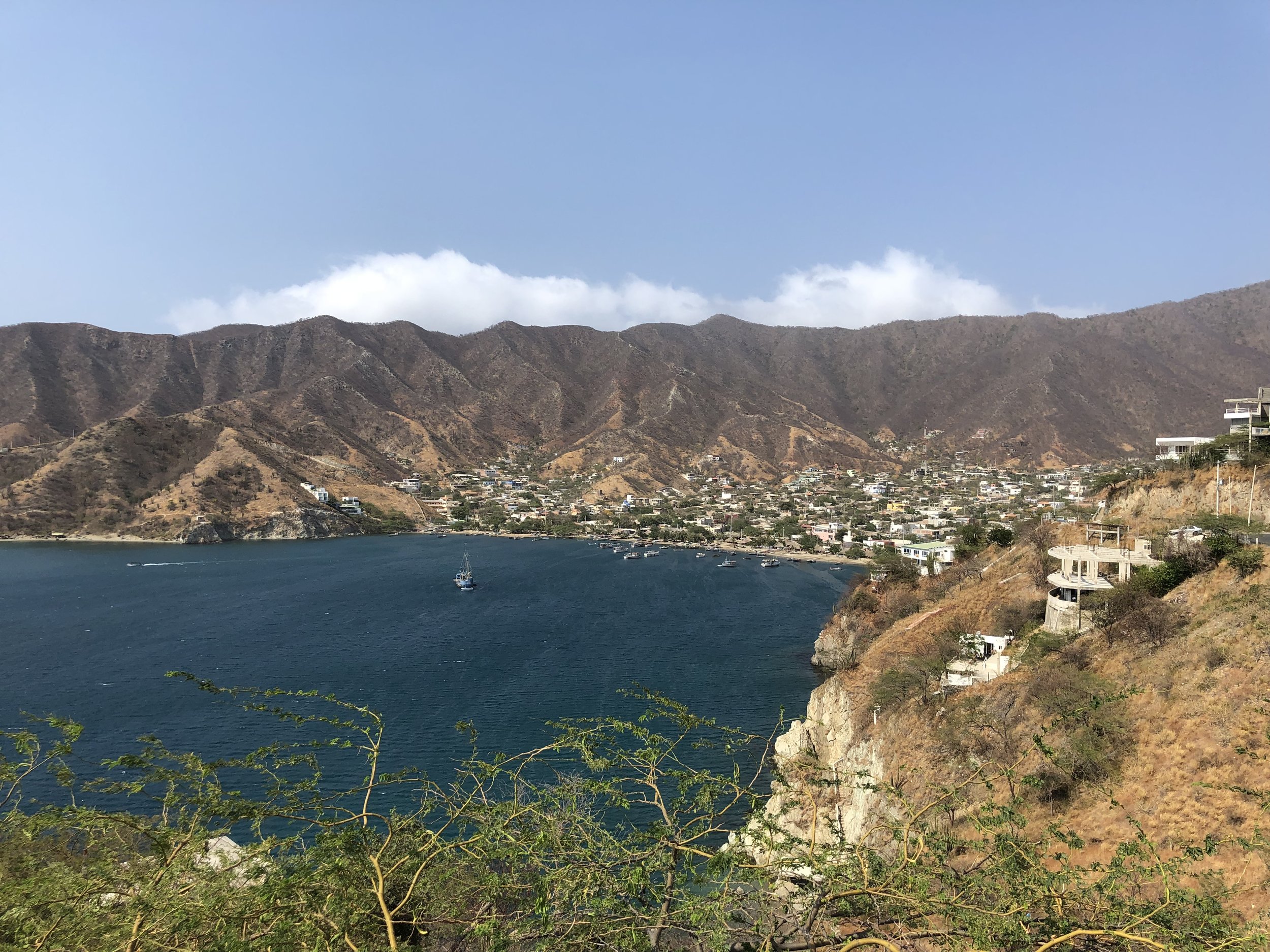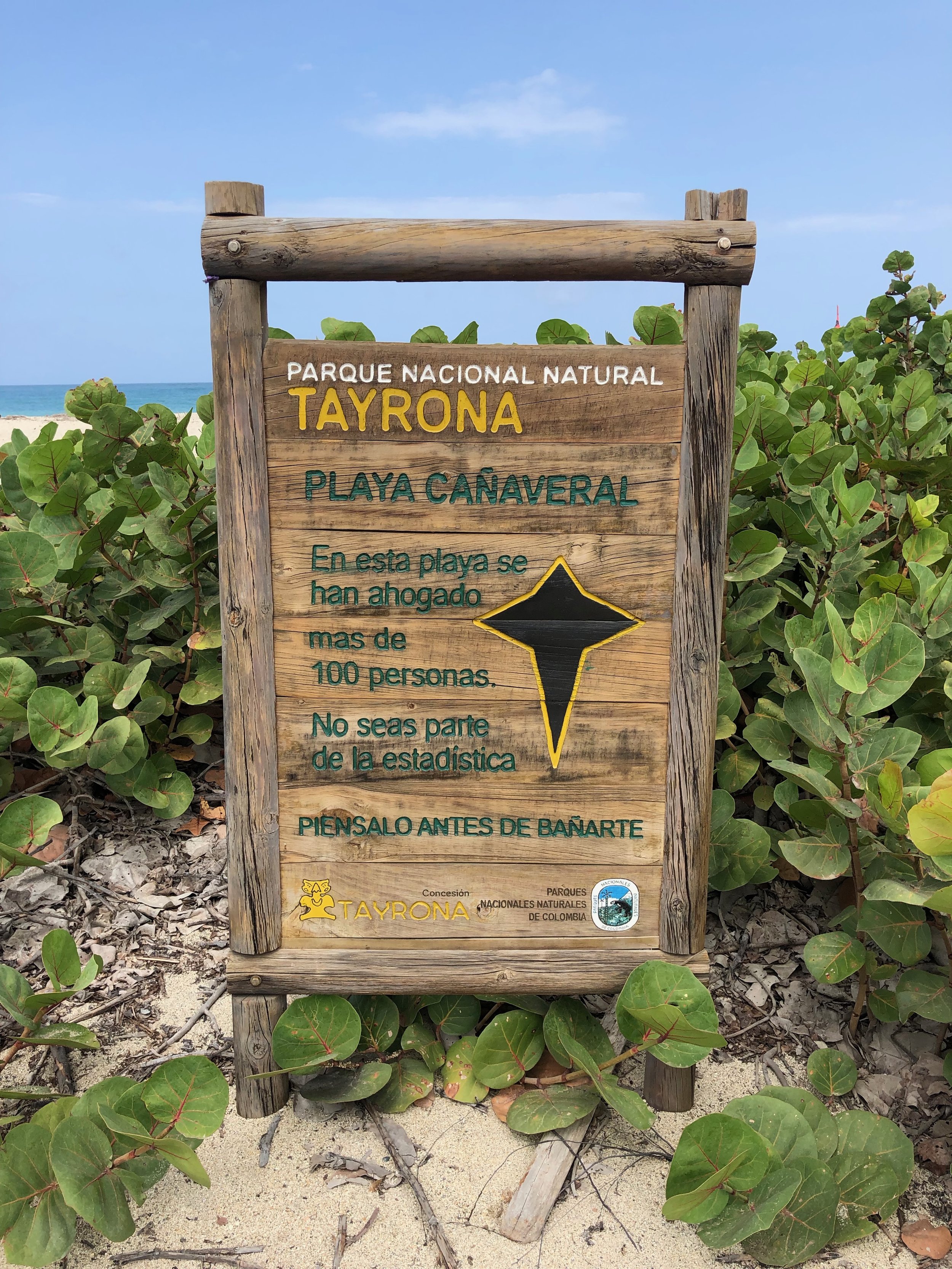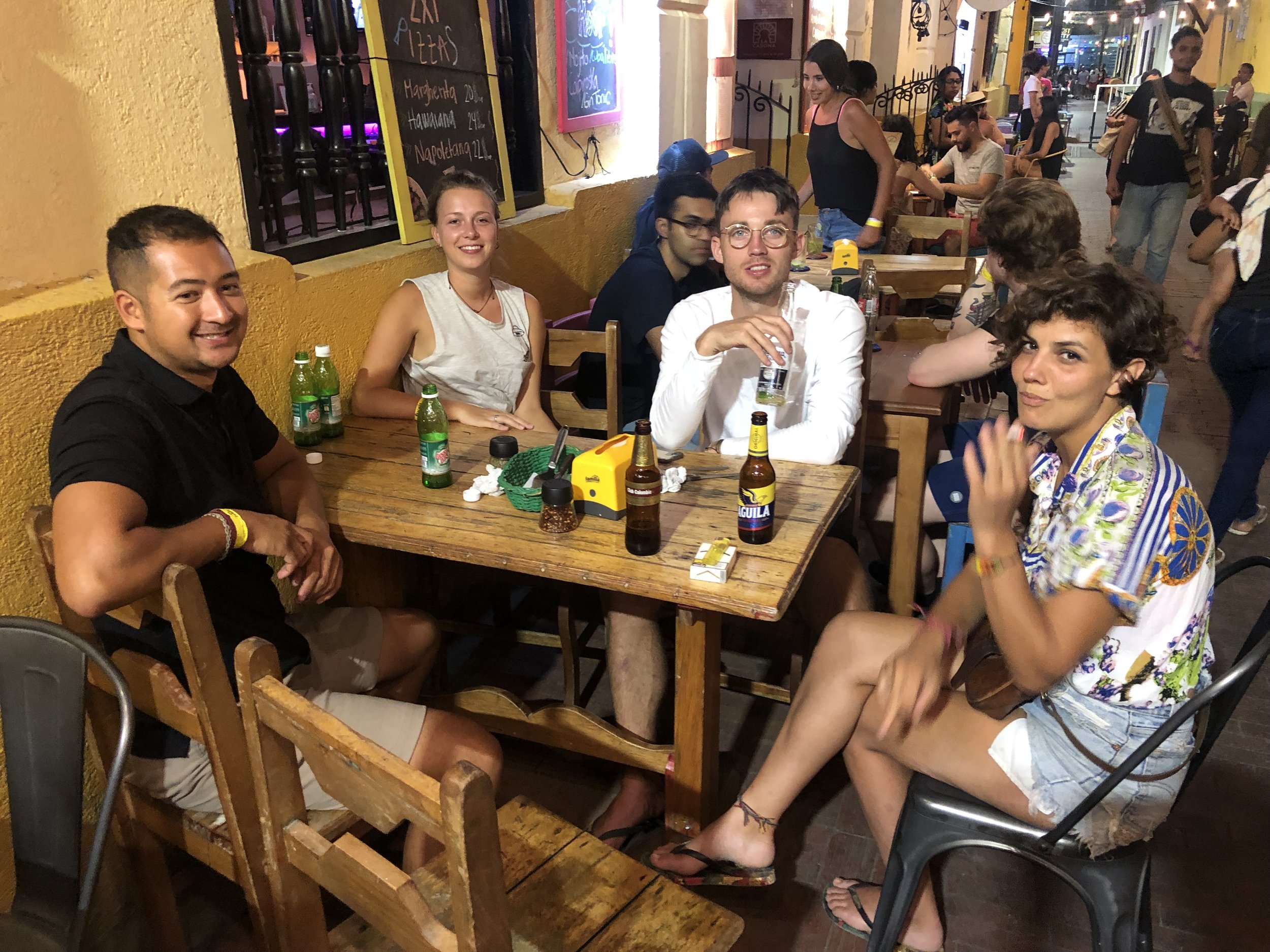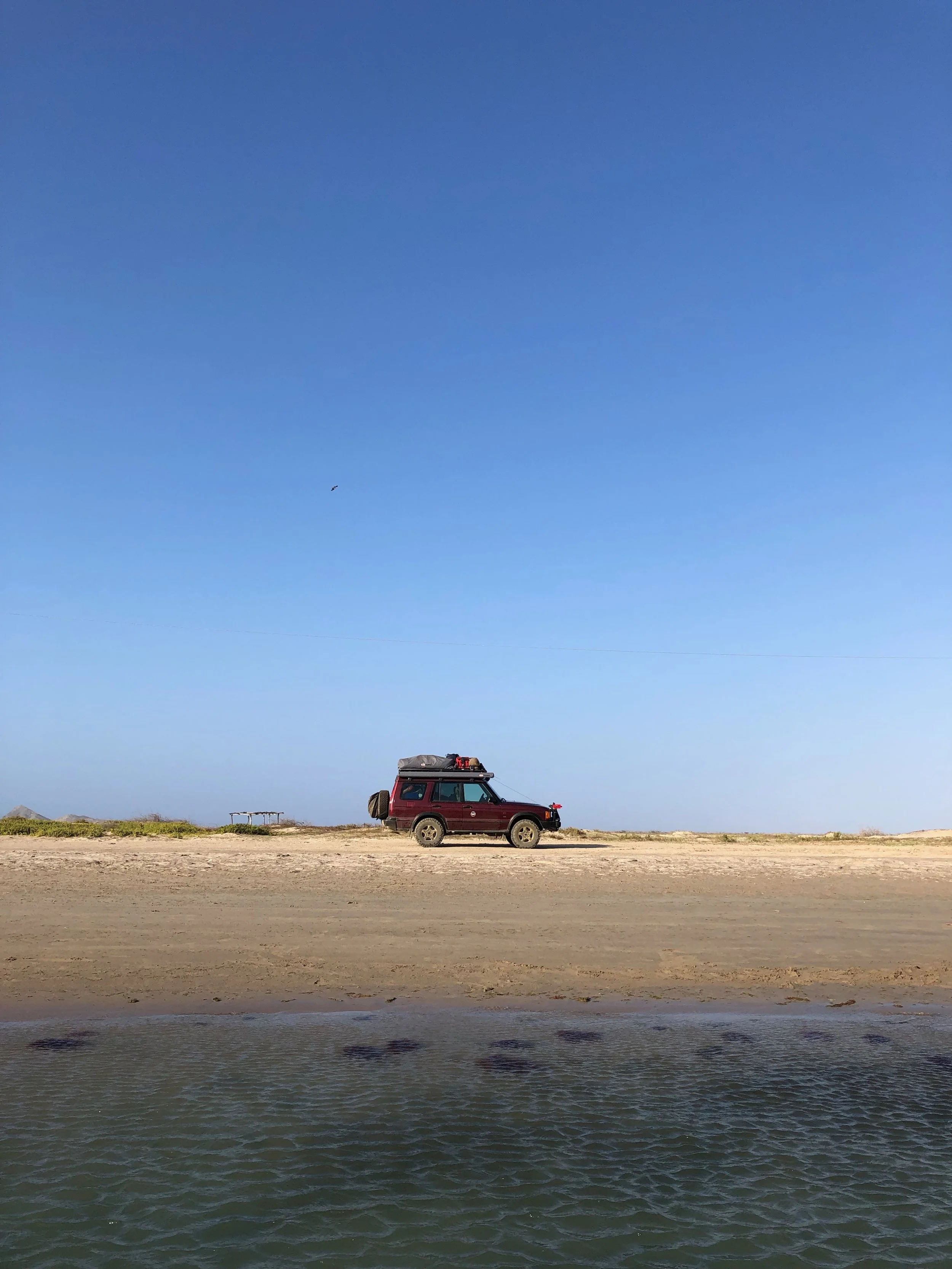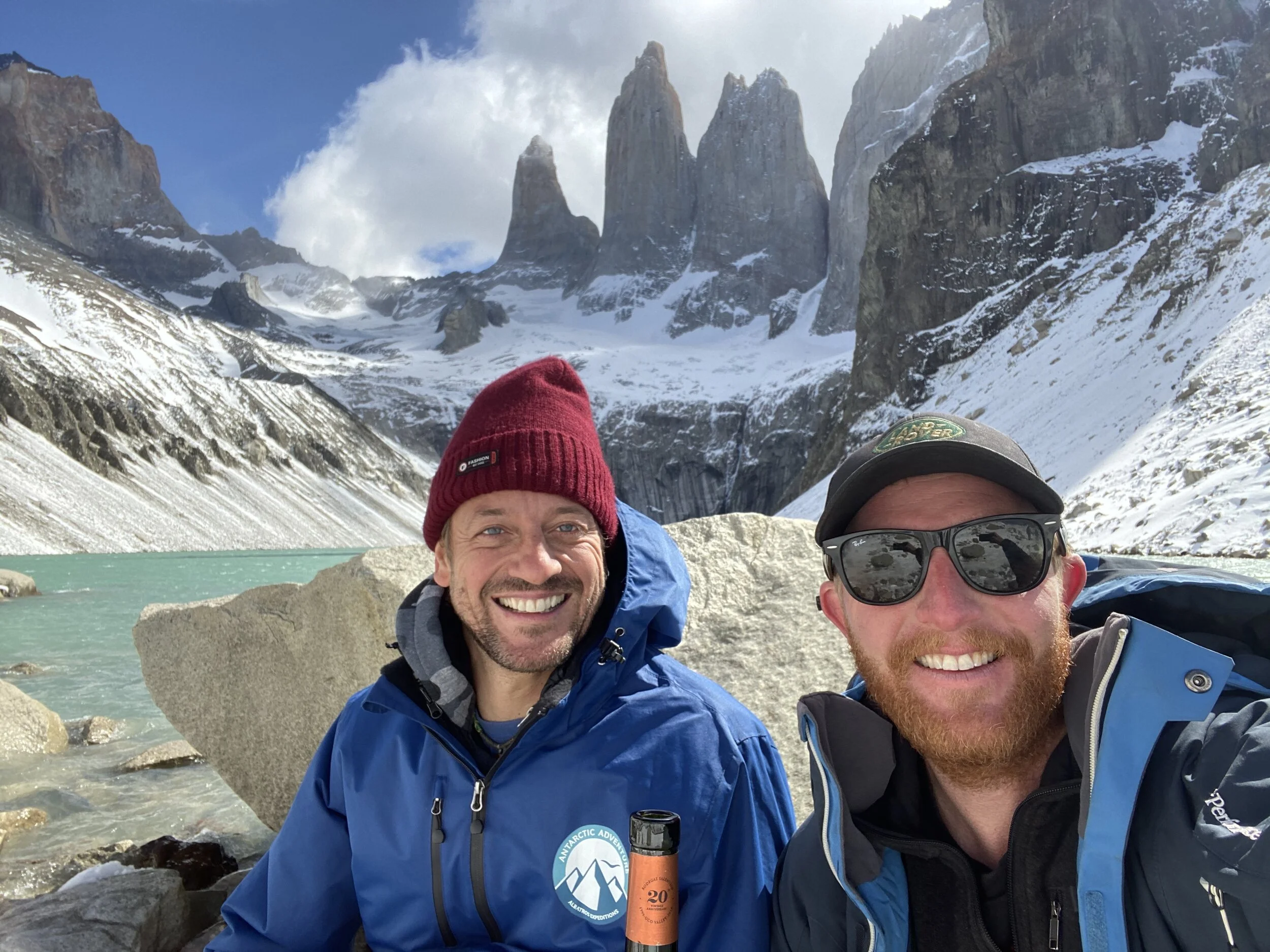Colombian North Coast (Pt 2)
5th March – 3rd April:
On the final day in Minca, we checked out a waterfall near our hostel and found a lovely French patisserie – supposedly as good as those in Paris according to my French friends - before hitting the road. Setting off north with the two French backpackers, I wasn’t certain whether I would drop them where they wanted to go and meet my friends or I would just follow the rabbit down the rabbit hole. Very early on in the drive I had made my decision that the greater adventure would be to spend time with these new people and see where it led. It was an amazing sense of freedom that i had acquired in my new expanded time horizon.
Our private waterfall outside of our Minca hostel (Rafael and I)
Margot & Raf looking for a table at Minca’s French patisserie which has the most amazing baguettes and dips
The new travel crew: Rafael, Margot and I
For our first day, we decided to find a nice beach as a starting point. We settled on a place called Mendihuaca half way between Santa Marta and Palomino. The beach was great and seemed a like a good camp spot. In what would become our standard operating procedure, we found some locals and asked if we could camp on their section of the beach for a small sum. They obliged and helped us source food and fire wood. We would spend the night with them drinking rum around the fire and the next day relaxing in hammocks with coconuts in hand.
Enjoying some downtime on Mendihuaca Beach. Rafael in the background put my machete to good use and headed up coconut acquisition for the group
A great spot on the north coast where the river meets the sea at Mendihuaca Beach
Home for the night: We enjoyed a healthy amount of rum with some locals around the fire with the car pulled right up onto the beach. Cold beers from the fridge, hot delivered chicken and some good times
Rafael being Rafael
Our goal was to head north and Margot and I decided to go to Cabo de la Vela together – the desert in the far north. Rafael only had a few days before his volunteer work at a local hostel would start. After a groggy start we headed via the town of Riohacha for supplies and then on to another beach camp at Playa Mayapo.
Playa Mayapo is a relatively small and seemingly abandoned fishing village. Despite numerous structures, there were only a handful of people around. Initially we opted for a quiet spot alone on the beach away from a noisy generator powering the only restaurant. But before setting up camp, we reconsidered and heeded the warnings of a young boy who had cautioned us against camping away from the restaurant in case we were robbed. Generally wild camping is discouraged in Colombia and it is suggest finding locals who are nearly always willing to let you camp on their property for the night. And for those that run restaurants, it’s a good way to source your food for the night and also nice to get some money back to them for their hospitality.
They served us fresh fish which we enjoyed with a couple bottles of wine and retired. Rafael and Margot slept in hammocks strung up between the support of the thatched roof. We woke up to breakfast, coffee and played with their newborn puppies.
Sleeping on the beach has its disadvantages … like no showers. But our solution was to sneak into hostels and clean ourselves (and in this case Margot taking the opportunity to wash her flip flops)
Our camp for the night in Playa Mayapo. I was in my rooftop tent and the others slept in hammocks
The seemingly abandoned fishing town of Playa Mayapo
In the end, I’m glad we opted for the safety of the restaurant grounds. During the night we were woken to the sound of several cars and their lights. There wasn’t any trouble but it reminded us that the smart move in Colombia is seeking out a local restaurant or home and getting the owner’s permission to stay on their property
Week old puppies with their mum
Our host’s kids showing us their new pets
Cabo de la Vela
Leaving Rafael behind, Margot and I headed for Cabo de la Vela. The town is in the far north and essentially a desert that meets the ocean near the Venezuelan border. We’d heard from other travellers that it was very impoverished and that the local children were thirsty due to severe lack of good drinking water. So knowing this, Margot encouraged us to head to the supermarket and buy as much water, rice and cooking oil as we could carry to take to local school kids.
The trip was four hours, the first half of which was simple. But eventually the roads disappeared and it became a drive through a sandy desert which many different trails and tire marks to follow. Thankfully Google Maps in this instance seemed to understand the most common way in and guided us safely through an otherwise unnavigable desert.
The desert of the La Guajira
Cabo de la Vela: Almost to the northernmost tip of the South American continent. We opted not to go to Punto Gallina (the actual northernmost tip) unguided because we’d heard there were issues with Venezuelan refugees in the desert that would hold up cars with chains across the road and then decide if they wanted to sell you something or rob you
Our shopping for the kids of the La Guajira
Cabo de la Vela itself is a village that occupies about a kilometre of coast line. It’s known by kite surfers for smooth water and consistent wind. But beyond a handful of rental shops that cater to the kite surfing crowd, there is relatively little else. Coming into the village was surreal. It was like nothing I’ve seen before. Lots of structures, many in disrepair, but very few people. There was next to nothing in terms of stores or restaurants, just shoddily constructed beach shelters, some basic accommodation, maybe one bar and a couple places to eat.
We pulled up on the beach, pulled out a cold beer from the fridge and went for a swim. After a little while we were joined by some local kids who were curious about us and the car. We were so used to being pestered to buy things, it was nice that these kids were just showing a genuine curiosity about us. We gave them some water and let them play in the car. We even went for a little drive where I let the kids sit on my lap and drive the car (while I operated the accelerator and brake for them).
After a quiet cocktail at the only beach bar and watching the sunset, we went in search of a place to camp. Like the past few nights, it was just a matter of finding a friendly family with some beach front property to let us park and camp. After a couple laps of the town, a nice family waived us down and offered to cook us lobster for dinner and let us park the night by the water’s edge.
Enjoying a cold beer and watching the kite surfers of Cabo de la Vela
One of the many unused buildings in the main strip of Cabo de la Vela
Hanging out with some thirsty and curious local kids
These guys were awesome. They seemed to like my Land Rover as much as I do
Right before we went for a spin and I let the kids drive the car (supervised of course with them on my lap)
Sun setting over the Caribbean coast
Our camp for the night. The owners made us a delicious meal of fresh lobster and fish
At the bar by the beach we’d met a woman, Gregoria, who promised to guide us around the local schools and help us responsibly distribute the food and water we’d brought. In the morning we set out to meet her and subsequently visited three small schools. The teachers welcomed us and helped us to pour cups of water for the kids and we watched them thirstily but respectfully share the water among themselves. It was a really heart-warming thing to watch the pleasure they had in drinking, but more so heartbreaking to know that we weren’t really making a meaningful difference – they would no longer be thirsty that morning, but come the afternoon and the next day, things would be exactly as they are.
I recently met up a friend in Bogota that I knew from Melbourne, Andrea Mayorga, who is working to provide water filters to the people of La Guajira to mitigate this problem. I hope that she and those involved are successful in getting this much needed equipment to the people there.
A local La Guajira school where Margot and I delivered water, rice and cooking oil to the students
One of the three schools we visited
Inside of the school pictured directly above
We found a place to have a shower – a cold bucket of water, a cup and a small concrete room – then started to head out. Stopping briefly for a climb up a hill (Pilón de Azúcar) and a stop at the beach, the drive took us back out through the desert and eventually ending up at the ‘hippy spring break’ town of Palomino. We hung around here for a few days to catch up on life, clean ourselves up and part ways. I would re-attach myself to Jessie and her group of friends for the next phase of the journey.
The local gas station
Climbing up the Pilón de Azúcar
One thing I’ve noticed about traveling / backpacking / overlanding with hitchhikers is that you meet people so frequently and for short periods of time that you risk every conversation being quite superficial. The usual ‘where are you from?’, ‘how long are you traveling?’, ‘what was such and such country like?’, ‘where are you headed next?’ become so common, you get tired of asking the questions and repeating yourself so many times. As such, it’s nice when you spend a meaningful amount of time with one person so you can break through all that fluff to get to really know someone. For me, Margot was a great travel companion because we shared much more than I did with most people and we understood each other as whole people, not backpackers, and each other’s problems and challenges. She and I stay in touch and we met again in Medellin again a month or so later when our paths crossed again. And I hope to do the same when I eventually cross through France.
Margot and I saying goodbye after an amazing journey up the coast together
Switching travel companions:
After spending a few days in Palomino relaxing and seeing a little of the town (but not much to be honest, I had work to catch up on), my friends from the sail boat arrived. It would mark the next small chapter of my travels up and down the North Colombian coast. I met Jessie and Fab (from the boat) and Stijn and Josh (friends of the first two) for dinner and drinks and this became the new travel group for the next while (with the exception of Fab who departed to head to Cabo de la Vela).
Meeting up with Jessie (Netherlands), Josh (US), Stijn (Netherlands) and Fab (Germany) at La Frontera in Palomino
Exploring the Minca region with a new composition of passengers
From Palomino, we shoot south along the coast to Santa Marta and over the hill to the small fishing town of Taganga for lunch. I resolve to come back here and do some fishing when time permits. But the crew is keen to see Minca and I agree to head back there despite having seen it already and cautious of the vicious biting sand flies. Our hostel is 8km up a winding and rocky dirt road which is no issue for the Land Rover but would be impossible for any non-4WD. I am a bit complacent in the freedom I have with my own car and not having bus routes and moto-taxis dictate where I go. It’s at times like this, I truly appreciate the freedom that comes with the overland versus the backpacker experience.
Overlooking the fishing village of Taganga
Jessie in the jungle
We spend the next few days exploring the jungle region around Minca and bouncing around hostels. Ultimately we all end up back in Santa Marta so I can drop everyone off and I can go meet Rafael again and go to the El Rio annual party that he’s been volunteering at. By this time I’ve gone back and forth up the coast road connecting the many northern towns many times and I know the road well. I’m hassled by police at checkpoints and the car is searched multiple times. They never seem to mind that the people in the car are drinking and they occasionally search the rear cargo area and drawers. I guess they’re looking for drugs but the searches are always quite light and they usually let us go quite quickly.
The giant hammocks of Casa Elemento in Minca
Exploring the region was made so much easier by having a car. I find it hard to imagine doing it any other way
A Colombian Experience:
When I was in Cartagena, I met a Colombian girl named Anita and we had spent some time together in the city. During my travels along the north coast, she told me that she wanted to get away from Cartagena and work for a little while and join me in the car to explore some of her own backyard. For me, embracing experiences with locals over backpackers is always the preference and so I invited her to join me for as long as she could get away.
Anita and I in Tayrona National Park
The first day together we headed towards Tayrona National Park. It’s a beautiful wilderness reserve that covers 30km of coastline on the Caribbean and offers both camping and luxury accommodation as you visit one beautiful beach after the next. The first night we found a great campsite by the beach with a quaint restaurant that more than satisfied our needs.
Our beach campsite in Tayrona
I upped my coffee game and picked up some essential equipment in Santa Marta. I added a V60 and a hand grinder to my travel kit. And there’s no shortage of good quality coffee beans in Colombia
Parque Nacional Natural Tayrona is mostly accessed via hiking or by horse. There’s limited ability to drive through. So despite my negative disposition towards horse riding, we hopped on some very slow horses towards Tayrona’s most famous strip of beaches. It’s a must stop destination if you ever travel this part of the world. Some backpackers on a budget are put off by the park entry prices but it’s worth every penny and something that should be seen.
Picturesque view in Tayrona National Park
I stopped riding horses more or less after a week long horse riding camp with my school as an early teenager The memories of my sore arse from that time has generally discouraged me getting on a horse ever since. I made the decision in this instance that it was more appealing that hiking for an hour in the tropical heat
Anita and I making our way to the stunning beaches of Tayrona
Panoramic picture of nicest beach we found
Feeling satisfied that we’d seen the best of Tayrona, I retraced my steps once again back through Santa Marta into Taganga, the fishing village that had struck me a week or so prior. Anita had some friends running fishing charters so we arranged for a day out in the boat. The fishing itself was mostly successful and I caught some species that I hadn’t before which is definitely a perk of traveling the world and encountering different oceans with different fish that aren’t back home.
All went well for the first three hours but at one point one of the lines caught the propeller and we ground to a halt. We threw out the anchor just in time to keep us only a few metres from the rocks. One of our two guides jumped in the water but wasn’t able to fix the problem after 30 minutes of trying to remove and fix the prop in the turning seas. I used my Garmin InReach to send a distress message to the charter agency while we tried to waive down passing boats for a tow. After perhaps an hour we managed to waive one down and they towed us to safety. Anita and I swam in the warm water of the bay while the guys fixed the prop in the calmer bay we’d arrived in. Doing a sufficient, but far from perfect, job they got it working enough for us to limp into harbour.
As is always my favourite thing to do, we had the fish cleaned and brought them to a beachside restaurant to prepare our fresh catch for lunch.
Our ‘lancha’ for the days fishing charter
The fishing gear was pretty low-tech but we came back with more than enough to eat that day and Anita was able to feed her friends with the rest a few days later
A Rex Hunt moment (for the Australian readers that get this reference)
The Garmin InReach is a great piece of kit for the overlander. I use it to track my location and past routes (see here: https://aus-share.inreach.garmin.com/longdrivesouth and click ‘View All Tracks'). But it also lets me send text messages when I’m out of cell phone coverage and in a more dire situation to hit an SOS button to get help on the way in an emergency.
Help to the rescue. This boat secured a rope to ours, pulled us off the rocks and towed us around the corner to the safety of a calm and quiet beach so we could repair the prop and limp back to the harbour
Enjoying the day’s catch with my favourite Colombian beer, Club Colombia
Apart from the fishing, Taganga is a beautiful place to stay and relax. There’s plenty of restaurants lining the beach and we found a quiet hotel overlooking the bay. It’s a great example of how the fortunes of small fishing town have been turned around by the inflow of tourists to Colombia that has come with the huge changes in perception over the past two decades. It’s in a nice phase where it’s not yet spoilt and overrun by travellers but has built up enough businesses to service them and is a nice balance between traditional fishing village and a destination for the Colombian visitor.
Ocean view from our hotel room in Taganga
Taganga: One of my highlight places to visit along the North Colombian coast
Santa Marta:
With Anita needing to get back to Cartagena and Jessie ready to meet again head south into the heart of Colombia, I returned to Santa Marta and dropped Anita off with some of her friends. Again, it seemed that I knew people all over town and so spent a few days enjoying the city with them. Santa Marta is a relatively large coastal port city with many lively night spots and not crowded with travellers the same way that some of the smaller towns are up and down the coast.
Kicking back at a bar / restaurant in Santa Marta
The Santa Marta port from a rooftop bar
Jessie and I excited to be reunited and getting ready to hit the road together
Enjoying the relative lively neighbourhood surrounding the Plaza de Santa Marta
We were very close to headed south with a third passenger. She eventually managed to return the dog to the street performer owner
Headed South:
Jessie and I bid goodbye to everyone we had been traveling with and jumped in the car to head south. The initial goal was to pass quickly through to Bucaramanga and on to some of the lovely little towns that potted the journey through to Bogota where we’d spend a few days and move on to Medellin to meet her friends for the weekend. We were successful in the first half of the plan but, yet did I know, I would get stuck a long time in Bogota.
Jessie and I somewhere between Santa Marta and Bucaramanga
With so much time spent on the beach, Jolene was due for a clean. Pretty sure this was about USD$5.00 for a thorough 45 minute hand wash
Adding another run in with the police to my tally. In this case I think I may have been speeding slightly. Usual process is that they ask for a huge amount of money (that you wouldn’t ever carry) and then I tell them I don’t have it. In this case I asked the policeman in Spanish if it was possible to pay less if I paid in cash now to which he replied ‘of course’. The alternative is not feasible and requires giving them your vital documents and searching for a police station and then trying to track down the policeman that detained you initially again. This sort of corruption has been the norm since Mexico with the possible exception of Costa Rica.
San Gil:
After a couple days of driving, the first interesting place we stopped was the town of San Gil. It’s a traditional Colombian town but also caters for the traveler in search of adventure sports. Many people head there for paragliding, white water rafting, canyoning, caving, water repelling and so on. I’m not in love with the backpacker routine of showing up to a new city, seeing what is the ‘done thing’ and then spending lots of money with other tourists doing tourist activities while avoiding the local culture. This is anathma to me and my preferred approach to take advantage of my car to get to places that other people don’t get to see. But we couldn’t resist seeing the stunning Chicamocha Canyon from the air.
Paragliding above Chicamocha Canyon outside of San Gil
The main square of San Gil
Villa de Leyva:
In San Gil, we managed to pick up a passenger in Josh Straus - a Toronto guy who’d been traveling north through South America. He was headed our way so he jumped in the car and joined us on our way to Villa de Leyva. Villa is a colonial town in the Boyaca region of Colombia. It’s known for its immense central square, Plaza Mayor, which is both the largest town square in Colombia and the largest cobbled square in South America.
Beyond the town itself, there’s also a reasonable amount to do in and around Villa de Leyva. We spent a day visiting wineries, a weird clay house, the charming and colourful town of Raquira, the Pozos Azules (a bitter disappointment) as well as the archaeological site known as “El Infiernito” (Little Hell) or the ‘Penis Park’ with its 109 giant sandstone penises.
The Plaza Mayor in Villa de Leyva
Picked up another hitchhiker: Josh (Toronto, Canada) was added to our travel team here. Great bloke and someone I’m sure I’ll see again down the track
I never quite figured out why this exists and who built it. But it was … interesting
Pozos Azules outside of Villa de Leyva. Hint: don’t go there. Underwhelming would be a understatement
Jessie very happy at the ‘Penis Park’ (aka the archaeological site El Infiernito)
Raquira: really charming little town painted in bright colours and filled with many handicrafts and nick-nacks. While it felt a little touristy, we didn’t see a single other extrañero (foreigner)
Villa de Leyva was our last stop until reaching Bogota. The initial intent with Bogota was to spend two or three days there and then meet Jessie’s friends in Medellin for a party on the weekend. In actual fact, I would go on to spend around five weeks in Bogota with my friends leaving me behind. That story I will save for the next post.

